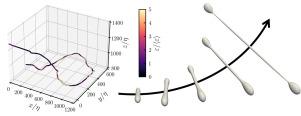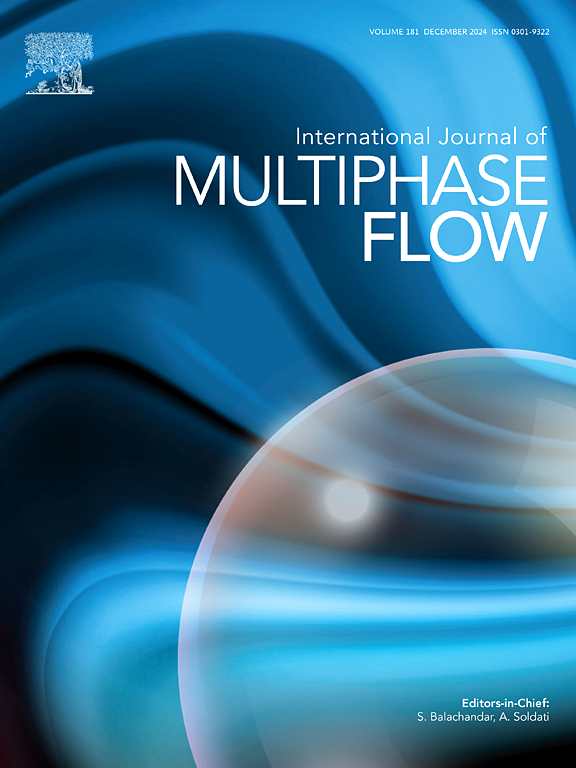Insights into sub-Kolmogorov-scale droplet breakup via boundary element simulations
IF 3.8
2区 工程技术
Q1 MECHANICS
International Journal of Multiphase Flow
Pub Date : 2025-09-26
DOI:10.1016/j.ijmultiphaseflow.2025.105460
引用次数: 0
Abstract
The statistics of sub-Kolmogorov-scale droplet breakup are investigated at a higher Taylor Reynolds number () than similar work at low (Cristini et al., 2003) to elucidate intermittency and neck pinch off behaviors. To this end, a boundary element method (BEM) is developed to enable simulations of the stochastic Stokes flow about ensembles of droplets along individual trajectories in homogeneous and isotropic turbulence (HIT), made possible through adaptive mesh refinement and fast multipole acceleration. Droplet deformation statistics, near-breakup behavior, and neck thinning statistics at are presented. Results highlight the effect of the HIT’s strain rate intermittency on the droplet deformation statistics, and investigations of subcritical and critical neck thinning events provide insights into the critical disturbances leading to breakup and transition of the neck contraction to the established viscous pinch-off regime. Both the marked influence of intermittency on the droplet deformation statistics and local strain rate effects very close into the terminal pinch-off regime emphasize the multiscale nature of the problem, even for droplets in the idealized Stokes regime.

通过边界元模拟深入了解亚柯尔莫哥洛夫尺度的液滴破裂
在较高的泰勒雷诺数(ReλT)下,研究了亚kolmogorov尺度滴滴破裂的统计数据,而不是在较低的ReλT下进行的类似工作(Cristini等,2003),以阐明间歇性和颈部掐断行为。为此,开发了一种边界元方法(BEM),通过自适应网格细化和快速多极加速,可以模拟均匀和各向同性湍流(HIT)中沿单个轨迹的液滴集合的随机斯托克斯流。给出了在ReλT≃310处液滴的变形统计、近破碎行为和颈部细化统计。结果强调了HIT的应变速率间歇性对液滴变形统计的影响,并且对亚临界和临界颈部变薄事件的研究提供了导致颈部收缩破裂和过渡到已建立的粘性夹断状态的临界干扰的见解。间歇性对液滴变形统计的显著影响和非常接近终端掐断状态的局部应变率效应都强调了问题的多尺度性质,即使对于处于理想斯托克斯状态的液滴也是如此。
本文章由计算机程序翻译,如有差异,请以英文原文为准。
求助全文
约1分钟内获得全文
求助全文
来源期刊
CiteScore
7.30
自引率
10.50%
发文量
244
审稿时长
4 months
期刊介绍:
The International Journal of Multiphase Flow publishes analytical, numerical and experimental articles of lasting interest. The scope of the journal includes all aspects of mass, momentum and energy exchange phenomena among different phases such as occur in disperse flows, gas–liquid and liquid–liquid flows, flows in porous media, boiling, granular flows and others.
The journal publishes full papers, brief communications and conference announcements.

 求助内容:
求助内容: 应助结果提醒方式:
应助结果提醒方式:


